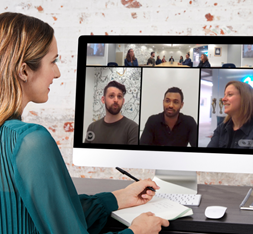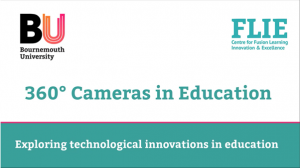From doorbells to diagnostics the use of 360° cameras, panoramic and omnidirectional footage has become commonplace for most people in 2022. Even before students embark on their educational journey at here at Bournemouth university, they may be using 360° tools and apps such as Google Maps simply to navigate to Bournemouth itself or by exploring the university campuses and its facilities via the online 360° campus virtual tour: https://virtualtour.bournemouth.ac.uk/
The use of 360° capture has also significantly increased as a result of the covid pandemic lockdowns where people could investigate the inaccessible by virtually exploring and experiencing digital artefacts in 360° online image capture and video. Coming out of the pandemic 360° technology has also been used to assist people with social anxieties by allowing them to view and virtually attend public spaces before the need for physical attendance.

There is already a plethora of research into the adoption of 360° capture in various educational settings. ‘One captivating aspect of 360° is its usage in the classrooms to improve the learning experience of students. This phenomenon has only been in rotation since the last decade. Educators are discovering that when students are provided with such rich, immersive media, they learn better and recall the information with higher successes’.
A study by Maria Ranieri, Damiana Luzzi, Isabella BruniRey et al explore 3 different approaches on using 360° video footage in differing educational settings:
- Lecturing: the 360° videos are used to represent a traditional transmissive lecture taking place in a typical teaching situation with a focus on the teacher within a formal context such as a classroom or a conference hall.
- Modelling: the 360° videos are used to show concrete procedures and activities; they generate a powerful sense of space, augmented and enhanced by the opportunity to deeply examine the environment and look at it from all angles, with a high sense of realism, also useful to arouse an emotional reaction.
- Exploring: the 360° videos can, in principle, bring learners everywhere and make them able to explore any place: natural landscape, internal environment or mixed environment (internal and external). They increase the learners’ control of the learning process, while encouraging curiosity and discovery. Link to study
Here in FLIE we have worked on various educational enhancing projects in support of TEL activities to promote the use of simulation in teaching and learning, we have 2 types of 360° cameras which we are currently using, the insta360 https://www.insta360.com/ which we have used in student demonstrations as well as co-created academically led projects to produce innovative teaching materials. We also have been experimenting with using the Meeting Owl for hybrid teaching and other hybrid activities https://owllabs.co.uk/
To highlight the use of 360° technologies and to showcase some examples of how they have been used in BU FLIE have created the following promotional video

Colleagues in FLIE are excited to find out about the various projects and teaching opportunities created by academic staff across BU through adopting 360° footage into their own course delivery and we are looking for future collaboration opportunities and projects.
How do I find out more?
If you have a project you would like to share with the TELID team or If you are interested in knowing more and would like a demonstration, please get in touch with your Faculty Learning Technologist who can provide more information.







